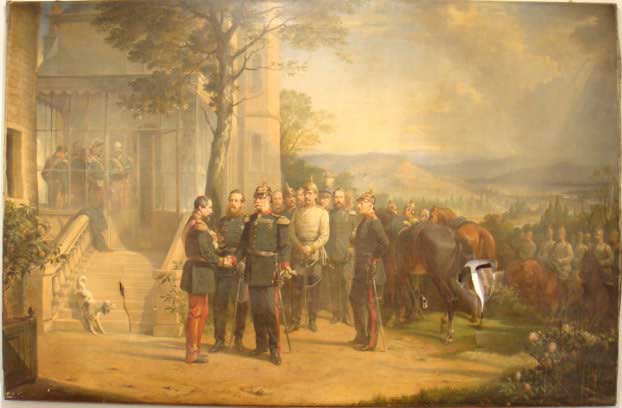Reprinted from Tela, 2009
The Painting Detective
It was leaning against the store room wall where it had gathered dust for over 25 years. Vanessa Mitchell lifted a corner of the sheet that covered it to reveal the back of a rather large painting, obviously in poor condition. She tilted the panel away from the wall and saw a group of military gentlemen assembled outside a chateau. “It’s Zidane” said her colleague.
Further research into portraits of Premier League footballers showed that she had slightly misheard. The untitled painting in fact shows the aftermath of the battle of Sedan in 1870 and was signed by Thomas Barker. It had been given to the Museum by the old Blackburn Royal Infirmary for safe storage (and because the Infirmary did not want it). If anyone knows why the Infirmary had such a painting in the first place, please let me know.
Vanessa found the picture’s full title in the Dictionary of National Biography for 1885 where it is listed in the article on Thomas Barker as ‘The Surrender of Napoleon the Third at Sedan’. The pages of the Illustrated London News reporting on the Franco-Prussian war showed that Barker had given true likenesses to the main characters in his painting; the diaries of the Emperor Frederick provided the exact location of the scene and more details of those present.
Frederick writes of the act of surrender ‘(I) advised against the meeting on the heights, in the presence of the troops, as humiliating; suggested that the King should ride to Bellevue to the Emperor. Conference with Bismarck, Roon and Moltke …’. The painting shows the Chateau of Bellevue with French officers lurking in the conservatory while Napoleon meets the Prussians.
Thomas Barker (1813 – 1882) made a good living from producing portraits and historical scenes. He was often present at the scenes he depicted, making his preliminary sketches while battles for example were still in progress.
His ‘The Secret of England’s Greatness’ (National Portrait Gallery) showing Queen Victoria presenting a Bible to an unknown African is much reproduced even if not always for artistic reasons. Galleries around the country contain examples of his work but he, like many of the Victorian genre painters, fell out of favour and many of his paintings were lost in the years around the First World War. Did Blackburn Royal pick up a bargain at this time?
Restoration
The picture is damaged and dirty, but is an interesting example of the work of a prominent Victorian artist. It was recently displayed in the Museum as part of an exhibition on restoration and conservation and aroused great interest. The Friends of the Museum agreed to pay for a condition report from the National Conservation Centre in Liverpool which showed that even though the overall condition is reasonable, there are major splits in the canvas, several smaller tears, missing flakes of paint and other minor blemishes. The cost of remedial treatment was estimated at over £10,000, though this could be divided into smaller, hence cheaper, units of work. The restored painting would then need to be framed to make it fit for display
Where does such money come from? No official funds exist, Lottery money cannot be used and a small museum has very little chance of raising such an amount on top of all its other expenses and priorities. Any ideas?
Woodmansterne Publications, who produce greetings cards amongst other items, offer art conservation awards which are much in demand. Bids must be made and unfortunately on this occasion the Museum’s bid was unsuccessful. In the collection is can be see the result of a previous bid in a restored painting of Ptarmigans by Joseph Wolf.


0 comments on “Thomas Barker: The Surrender of Napoleon the Third at Sedan”